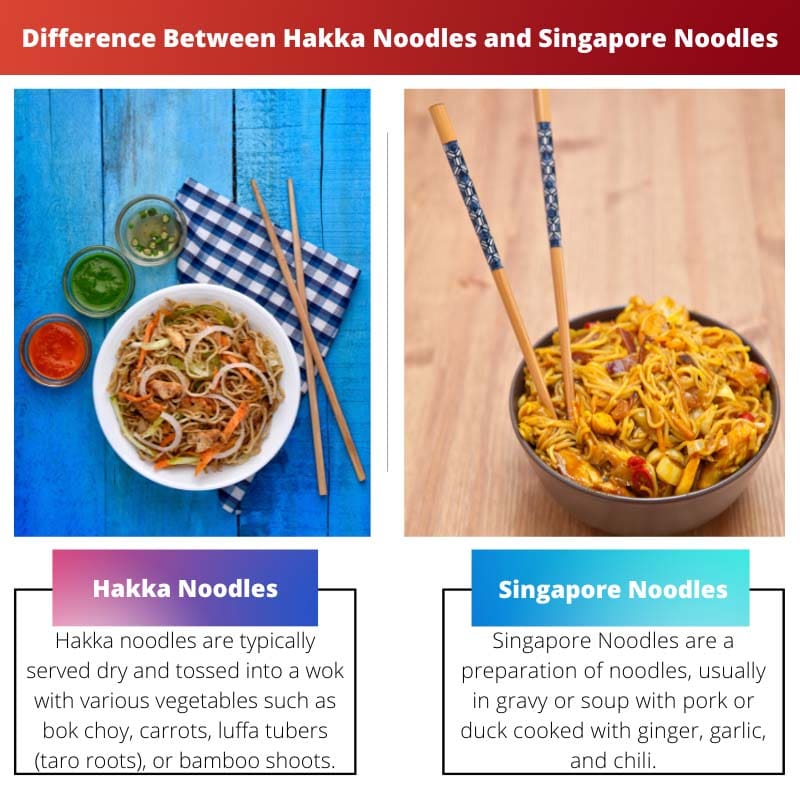Hakka noodles were originally brought to China by Hakka immigrants from present-day North India during the Qing dynasty. The sylvan flavors of the dish include soy sauce, Sichuan pepper, five-spice powder, and star anise.
It is served with a mix of preserved vegetables like carrots or winter melon or other preserved ingredients like shrimp paste, which gives it a strong fishy taste.
Rice vinegar is mixed into the broth before cooking, whereas Singapore noodles is a dish that includes rice noodles stir-fried with vegetables in a spicy and savory gravy.
Key Takeaways
- Hakka Noodles are thicker and made with egg and wheat flour, while Singapore Noodles are thinner and rice vermicelli.
- Hakka Noodles are Indian-Chinese cuisine, whereas Singapore Noodles are popular in Singaporean cuisine.
- Hakka Noodles are stir-fried with vegetables and meats, whereas Singapore Noodles are stir-fried with shrimp, pork, and various vegetables.
Hakka Noodles vs Singapore Noodles
The difference between Hakka Noodles and Singapore Noodles is that Singapore noodles contain a gravy-like sauce which is much different than the crispiness of Hakka noodles. Hakka noodles are served dry and tossed into a wok with various vegetables, making for crunchy bites that can range from tangy to sweeter.

Singapore Noodles are a preparation of noodles, in gravy or soup with pork or duck cooked with ginger, garlic, and chili. It is served in Singapore and neighboring areas of Malaysia and Indonesia.
The local variant shares many similar qualities to the Hakka noodle dish but differs in that its ingredients are more culturally sensitive
Hakka noodles are served dry and tossed into a wok with various vegetables such as bok choy, carrots, luffa tubers (taro roots), or bamboo shoots.
The resulting dish is crunchy, with a tangy taste. The resultant dish is crunchy and has a tangy taste.
Comparison Table
| Parameters of Comparison | Hakka Noodles | Singapore Noodles |
|---|---|---|
| Ingredients | Ingredients used in Hakka Noodles are mainly noodles and minced pork with the egg which are stir-fried | Ingredients used in Singapore noodles can vary greatly from shrimp, pork, and fish balls to dried squid |
| Main Base | These consists of finer noodles | These consists of thin dried rice vermicelli |
| Thickness | Thicker than Singapore noodles | Less thick than Hakka noodles |
| Spiciness | Ranges from flavorless to spicy | Mainly spicy |
| Number of Ingredients | These are made from five ingredients, including wheat flour, sometimes with white radish (daikon) powder, baking soda, salt, and water. | These are made from six ingredients, including flour (wheat flour), water and salt and rice powder, or corn starch to make the noodles yellow instead of using turmeric powder |
What are Hakka Noodles?
Hakka noodles are a well-accepted dish fabricated by the Hakka people, who came from Central and Northern China. Hakka noodles are made with wheat flour, eggs, oil, salt, and sesame seeds.
The noodles are then steamed in an iron pot of boiling water for about two or three minutes before draining them. The dish is flavored with a sauce that can be either salty or sweet, depending on individual liking.
Hakka noodles are a staple in many East Asian households. A variety of different varieties exist, including Singapore-style, Hong Kong-style, and Japanese ramen.
They are chewy and thin with a slightly sweet flavor and crispy texture. The noodles are cooked in boiling water and served with a rich, brothy soup or on the side.
Hakka Noodles can be served hot or cold depending on individual taste and preference. Hakka Noodles are eaten as lunch or dinner and are accompanied by a bowl of rice.
Hakka noodles are also common in Malaysia and Singapore, where it is referred to as Hokkien Mee (Hokkien for the Chinese-speaking residents of Fujian Province mee means noodle).

What are Singapore Noodles?
A popular dish made from these flat strips of dough is Singapore noodles, which originated in Singapore and Malaysia, but has now been adopted by many other countries such as Japan, Vietnam, China, and Indonesia.
Singapore noodles are stir-fried thin rice stick noodles mixed with a variety of ingredients such as cockles, fish cake, eggs, and bean sprouts.
They are commonly served with gravy which is made from soy sauce and oyster sauce. The gravy thickens when it comes in contact with the noodles giving a distinctive taste to the dish a sweet and savory at the same time.
This dish is popular among Singaporeans and can be found in Singapore’s hawker food centers, food courts, or even at home as a quick snack from take-out shops or food stalls on the streets.
It is also served in other countries; however, it may be prepared differently. For example, more vegetables may be added, or the gravy may vary.
There are many different versions of Singapore Noodles in the world. They can be served with a variety of sauces and can also have chicken, beef, or shrimp.
There are also cold and hot varieties of this dish so people can choose what they want to eat. According to the Singapore government, restaurants in the country should serve fresh and homemade Singapore Noodles so they will be safe to eat.

Main Differences Between Hakka Noodles and Singapore Noodles
- The Hakka Noodles are soft, whereas rice noodles in Singapore Noodles are denser, not as soft.
- There is no crispy bottom on Hakka noodles, whereas there is no crispy bottom on Singapore Noodles.
- The traditional Hakka noodles don’t have any vegetables in them, whereas the traditional Singapore noodles don’t have any vegetables in them.
- Hakka noodle dish does not include protein such as shrimp, chicken, and pork, whereas a Singapore noodle dish always include protein such as shrimp, chicken, and pork,
- Hakka noodles are stir-fried, whereas Singapore Noodles are boiled and dried.

- https://link.springer.com/chapter/10.1007/978-3-319-12865-8_3
- https://www.airitilibrary.com/Publication/alDetailedMesh?docid=10289488-201312-201312160001-201312160001-241-249
- https://www.airitilibrary.com/Publication/alDetailedMesh?docid=10289488-201606-201606210011-201606210011-93-101
